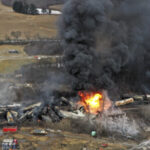The threat of destructive flooding from a monstrous Sierra Nevada snowpack that supplies Los Angeles, Calif., with its water led Mayor Eric Garcetti to declare an emergency Monday to protect the city’s aqueduct system and the people who live nearby.
Flooding is not a threat in the nation’s second-largest city. But it could swamp the rural Owens Valley hundreds of miles north, which has long had a fraught relationship with the metropolis that surreptitiously bought rights to its water and channeled it south more than a century ago.
The action clears the way for the Department of Water and Power to spend up to $500 million to respond to what it described as a danger to public health and safety and to protect infrastructure and the environment. The agency can spend the money without jumping through bureaucratic hoops.
“Because this climate event has been as dramatic as it was, we know that while natural disasters sometimes are not in our power to mitigate, this one is, especially if we act now,” Garcetti said. “We don’t want lives to be upended, families hurt, jobs lost because we waited too long and did not take action.”
The aqueduct runs hundreds of miles south from the arid valley to Los Angeles and can provide enough water to the city in a wet year. Near-record snow this winter following five years of drought, however, was projected to provide twice the amount of water the city needs.
That could overwhelm the channel and flood the sparsely populated area at the foot of the eastern Sierra. DWP is using aqueduct water to replenish local aquifers and emptying reservoirs to create more capacity.
Water spilling from the aqueduct to soak into the arid terrain already can be seen flooding areas adjacent to U.S. Route 395, the main highway through the valley, said Inyo County Supervisor Dan Totheroh.
As temperatures climb later in the spring, already engorged rivers could overflow and top bridges, he said.
Up to a fifth of predicted runoff will end up in Owens Lake, which dried up when Los Angeles siphoned its water source into the aqueduct more than 100 years ago.
The dried lake bed has been a major source of air pollution in the area and DWP is required by court settlements dampen it to control unhealthy dust.
In high-water years in 1969 and 1983, the lake was allowed to fill and evaporate, but the city has spent over $1 billion this century to put dust control measures in place. Pipes, berms and vegetation planted to control dust could be damaged with the lake predicted to rise up to 7 feet.
Much of the money spent in coming weeks will go toward protecting that infrastructure by digging channels to better direct water into the lake bed and other efforts, said Richard Harasick, the head of DWP’s water system.
After severe drought throughout the state, the runoff is likely to provide abundant water to cattle ranchers and other farmers in the valley to irrigate pastures. Some got no water from DWP last year.
Totheroh said the area will probably get more water than it can use.
“It may be more damaging than drought, but potentially good rather than bad,” he said.
Was this article valuable?
Here are more articles you may enjoy.

 Viewpoint: Striking Risk-Reward Balance for Shipping Lithium-Ion Batteries
Viewpoint: Striking Risk-Reward Balance for Shipping Lithium-Ion Batteries  Report: Autonomous Vehicle Jobs to Exceed 110k in U.S.
Report: Autonomous Vehicle Jobs to Exceed 110k in U.S.  Norfolk Southern to Pay $600 Million to Settle Ohio Spill Case
Norfolk Southern to Pay $600 Million to Settle Ohio Spill Case  Texas Among Several States Facing New Fire Risks: Weather Watch
Texas Among Several States Facing New Fire Risks: Weather Watch 